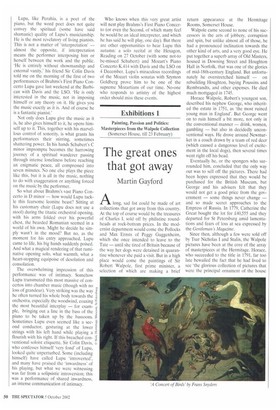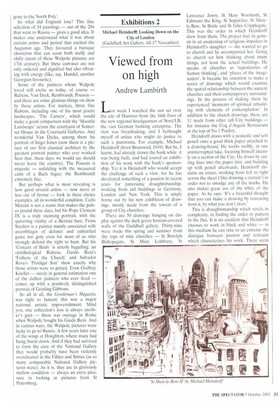The great ones that got away
Martin Gayford
Along, sad list could be made of art collections that got away from this country. At the top of course would be the treasures of Charles I, sold off by philistine roundheads at rock-bottom prices. In the modernist department would come the Po!locks and Max Ernsts of Peggy Guggenheim, which she once intended to leave to the Tate — until she tired of Britain because of the way her dogs were detained in quarantine whenever she paid a visit. But in a high place would come the paintings of Sir Robert Walpole, first prime minister, a selection of which are making a brief
return appearance at the Hermitage Rooms, Somerset House.
Walpole came second to none of his successors in the arts of jobbery, corruption and spin, but unlike almost all of those, he had a pronounced inclination towards the other kind of arts, and a very good eye. He put together a superb array of Old Masters, housed in Downing Street and Houghton Hall in Norfolk, that was one of the glories of mid-18th-century England. But unfortunately he overstretched himself — on rebuilding Houghton, buying Poussins and Rembrandts, and other expenses. He died much mortgaged in 1745.
Horace Walpole, Robert's youngest son, described his nephew George, who inherited the estate in 1751, as 'the most ruined young man in England'. But George went on to ruin himself a bit more, not only in the conventional manner — drink, women, gambling — but also in decidedly unconventional ways. He drove around Newmarket in a coach drawn by a team of red deer (which caused a dangerous level of excitement in the local dogs), then several times went right off his head.
Eventually he, or the spongers who surrounded him, concluded that the only way out was to sell off the pictures. There had been hopes expressed that they would be purchased for the British Museum, but George and his advisers felt that they would not get a good price from the government — some things never change — and so made secret approaches to the Empress of Russia. In 1779, Catherine the Great bought the lot for £40,555 and they departed for St Petersburg amid lamentations and fears of loss at sea expressed by the Gentleman's Magazine.
Since then, although a few were sold off by Tsar Nicholas I and Stalin, the Walpole pictures have been at the core of the array of masterpieces at the Hermitage. Horace, who succeeded to the title in 1791, far too late bewailed the fact that he had lived to see 'the glorious collection of pictures that were the principal ornament of the house gone to the North Pole'.
So what did England lose? This fine selection of 34 paintings — out of the 204 that went to Russia — gives a good idea. It makes one understand what it was about certain artists and period that excited the Augustan age. They favoured a baroque classicism that can seem both stuffy and chilly (most of these Walpole pictures are 17th century). But these canvases are not only ordered and dignified but also vibrating with energy (like, say, Handel, another Georgian favourite).
Some of the painters whom Walpole loved still excite us today, of course — Rubens. Van Dyck, Rembrandt, Poussin — and there are some glorious things on show by those artists. For starters, three fine Rubens, including one of his most poetic landscapes, 'The Carters', which would make a good comparison with the 'Moonlit Landscape' across the courtyard of Somer set House in the Courtauld Galleries. And wonderful Van Dycks, among them his portrait of Inigo Jones (now there is a pic ture of our first classical architect by the greatest portrait painter who ever worked here that, these days, we would say should never leave the country). The Poussin is majestic — unfolding with the measured calm of a Bach fugue; the Rembrandt extremely fine.
But perhaps what is most revealing is how good several artists — now more or less out of favour — look in these choice examples, all in wonderful condition. Carlo Maratti is not a name that makes the puls es pound these days, but his Pope Clement IX is a truly stunning portrait, with the quivering vitality of a Bernini bust. Frans Snyders is a painter mainly associated with assemblages of defunct and embattled game too gory even for most of us who strongly defend the right to hunt. But his 'Concert of Birds' is utterly beguiling: an ornithological Rubens. Guido Reni's 'Fathers of the Church' and Salvador Rosa's 'Prodigal Son' show exactly why those artists were so prized. Even Godfrey Kneller — surely in general estimation one of the dullest painters who ever lived — comes up with a positively distinguished portrait of Grinling Gibbons.
So all in all, the Gentleman's Magazine was right to lament: this was a major
national artistic impoverishment. Mind you, one collection's loss is always another's gain — there was outrage in Rome when Walpole bought his Guido Reni. And in various ways, the Walpole pictures were lucky to go to Russia. A few years later one of the wings at Houghton, where many had hung, burnt down. And if they had survived to form the core of the National Gallery they would probably have been violently overcleaned in the Fifties and Sixties (as so many comparable National Gallery pic tures were). As it is, they are in gloriously mellow condition — always an extra pleasure in looking at pictures from St Petersburg.





































































 Previous page
Previous page